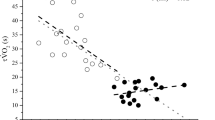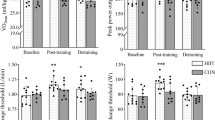Abstract
Endurance training increased\(\dot V{\text{O}}_{\text{2}} \) max significantly from 71.6±1.3 to 81.5±1.7 ml·kg−1·min−1 in female rats. Oxygen consumption and respiratory exchange ratios were observed in rats for 1 h at rest, running at 14.3 m·min−1 on a 1% grade (easy exercise), and running at 28.7 m·min−1 on a 15% grade (hard exercise). In hard exercise untrained rats had a higher respiratory exchange ratio (0.97 vs 0.90) and exercised at a higher percent\(\dot V{\text{O}}_{\text{2}} \) max (92 vs 74%) than trained animals. Blood lactate was higher during hard exercise than during rest or easy exercise, and higher in untrained than in trained animals during exercise. Blood glucose was significantly higher in trained than in untrained animals during hard exercise, but otherwise there were no differences between treatments or groups. These results suggest enhanced lipid oxidation and carbohydrate sparing in trained rats during prolonged exercise as the result of training. The improvement in whole-body\(\dot V{\text{O}}_{\text{2}} \) max due to training (13.9%) was less than the increase in tissue respiratory capacity (50–100%) reported to accompany endurance training of rats. The improvement in\(\dot V{\text{O}}_{\text{2}} \) max of rats as the result of training was of the same magnitude as the training response usually seen in humans.
Similar content being viewed by others
References
Åstrand PO, Rodahl K (1977) Textbook of work physiology, McGraw-Hill, New York pp 318–319
Baldwin KM, Campbell PJ, Cooke DA (1977) Glycogen, lactate and alanine changes in muscle fiber types during graded exercise. J Appl Physiol 43:288–291
Baldwin KM, Kinkerfuss GH, Terjung RL, Mole PA, Holloszy JO (1972) Respiratory capacity of white, red and intermediate muscle: adaptive response to exercise. Am J Physiol 222:373–378
Barnard RJ, Edgerton VR, Furukawa T, Peter JB (1971) Histochemical, biochemical, and contractile properties of red, white and intermediate fibers. Am J Physiol 220:410–414
Brooks GA, White TP (1978) Determination of metabolic and cardiac frequency responses of laboratory rats to treadmill exercise. J Appl Physiol: Respirat Environ Exercise Physiol 45:1009–1015
Donaldson HH (1924) The rat, Philadelphia: Wistar Institute of Anatomy and Biology
Fitts RH, Booth FW, Winder WW, Holloszy JO (1975) Skeletal muscle respiratory capacity, endurance, and glycogen utilization. Am J Physiol 228:1029–1033
Hohorst HJ (1963)l-(+)-lactate: Determination with lactic dehydrogenase and DPN. In: Bergmeyer H-U (ed), Methods of enzymatic analysis. Academic Press, New York pp 266–270
Holloszy JO (1967) Effects of exercise on mitochondrial oxygen uptake and respiratory enzyme activity in skeletal muscle. J Biol Chem 242:2278–2282
Holloszy JO, Booth FW (1976) Biochemical adaptation to endurance excercise in muscle. Ann Rev Physiol 39:273–291
Krebs HA, Yoshida T (1963) Muscular exercise and gluconeogenesis. Biochem Z 338:241–244
McArdle WD (1967) Metabolic stress of endurance swimming in the laboratory rat. J Appl Physiol 22:50–54
Molé PA, Oscai LB, Holloszy JO (1971) Adaptation of muscle to exercise: Increase in levels of palmityl CoA dehydrogenase, and in the capacity to oxidize fatty acids. J Clin Invest 50:2323–2330
Oscai LB, Holloszy JO (1971) Biochemical adaptations in muscle II. Response of mitochondrial adenosine triphosphatase, creatine phosphokinase and adenylate kinase activities in skeletal muscle to exercise. J Biol Chem 246:6968–6972
Shepherd RE, Gollnick PD (1976) Oxygen uptake of rats at different work intensities. Pflügers Arch 362:219–222
White TP (1977) Influence of metabolic rate upon the metabolism of lactic acid and the oxidation of glucose, alanine, and leucine. Doctoral dissertation, University of California
Author information
Authors and Affiliations
Rights and permissions
About this article
Cite this article
Patch, L.D., Brooks, G.A. Effects of training on\(\dot V{\text{O}}_{\text{2}} \) max and\(\dot V{\text{O}}_{\text{2}} \) during two running intensities in rats. Pflugers Arch. 386, 215–219 (1980). https://doi.org/10.1007/BF00587471
Received:
Accepted:
Issue Date:
DOI: https://doi.org/10.1007/BF00587471




